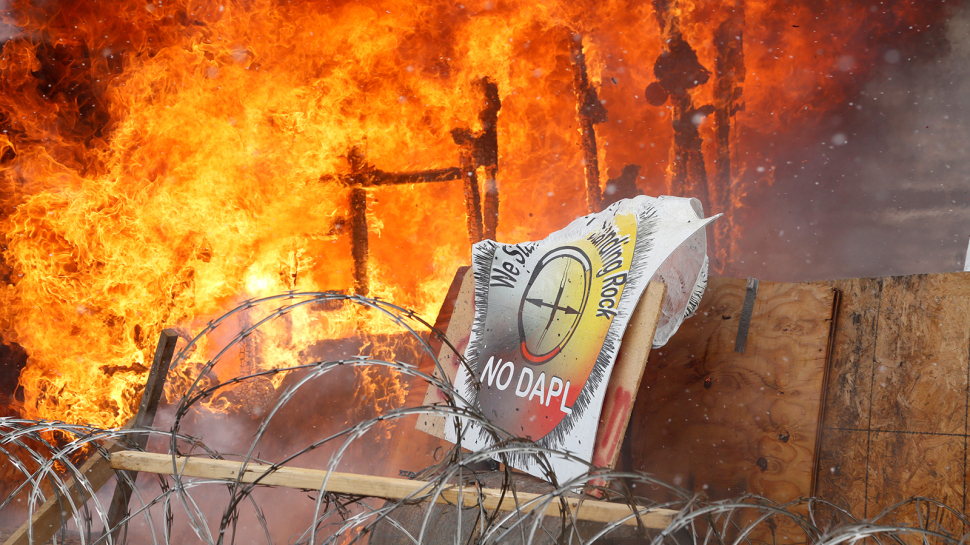After half a year, hundreds of arrests, and thousands of headlines, the protest against the Dakota Access Pipeline has drawn to an end at the Standing Rock site. On February 22, North Dakota Gov. Doug Burgum forced an evacuation of the protesters’ camps. The government needed time to clean the environmental mess the environmentalists left behind.
That paradoxical reality underscores many of the problems with efforts that claim to solve potential problems. In the end, this lengthy “protest” accomplished none of its stated goals, cost millions to those on both sides, and left the area in crisis thanks to the very sorts who claimed to be there as a form of protection.
Instigated by resistance and lawsuits brought forth by the Standing Rock Sioux Tribe, protesters descended on the flats of the Cannonball River plain and encamped to resist the construction of the Dakota Access Pipeline. The tribe has been in court battling the Army Corps of Engineers over the pipeline. Tribal elders resisted despite the dubious merit of complaints this construction would violate sacred tribal lands and threaten their water supply, even though numerous other pipelines already run through these lands.

We Just Want to Take a Toll
The tribe may have been actually just haggling over compensation. The Washington Examiner reported that during talks with the group representing the pipeline construction—Energy Transfer Partners—the tribe had been given a number of offers. Addressing the concerns cited, ETP pledged water monitoring systems and pipeline emergency support.
These offers were not accepted: “time and again the tribe rebuffed or ignored the company’s offers demanding, instead, a toll on the crude that passed through the pipeline, an ultimatum that showed the tribe’s true desire — easy money.”
With that protester from across the country, emboldened by numerous celebrity supporters, poured into the South Dakota region. The new encampment held thousands of protesters. These were well-funded, long-term activists given the dwellings they constructed and supplies shipped into the squatters.
Earth First—Or Second, Or At Least In the Top Ten
As the media played along with the spokespersons, relaying the message of “peaceful” protesters,” protesters clashed numerous times with authorities. Access roads to the camp were blocked with machinery and environmentally friendly tire fires. Many of these led to numerous arrests. North Dakota tabulated the cost for its taxpayers to monitor, control, and babysit these protesters since they began arriving on August 10, 2016: $33 million.
South Dakota also recorded more than 700 arrests in the course of those six months, and 92 percent of those arrested were from outside the state. Over one-third of those were people with prior criminal records, totaling 1,400 charges. These cannot be dismissed as solely charges from prior protests, for the majority were arrested over thefts or violence.
In a separate lawsuit brought against the government in court, representatives of the protesters claimed they were victims of brutality during the conflicts. The law enforcement defendants submitted lengthy paperwork displaying the voluminous amount of threats of violence from the protesters on social media and other outlets.
An early sign of hope was President Obama declaring an end to the construction project. Invoking environmental concerns, on November 6 he signed an order halting the construction. Donald Trump’s election a few days later led to a quick reversal in a new executive order on January 24.
We Love the Earth So Much We’ll Destroy It
As the protest stretched into December no end to the conflict appeared in sight. A particularly brutal snowstorm changed things drastically. As drifts of snow blew in overnight, the crowds plummeted from thousands to just a few hundred die-hards. Most of those fled instantly, abandoning the items they had trucked in. This exposed a monumental environmental threat at the location, created entirely by environmentalists.
The main camp was located at the Cannonball-Missouri confluence that was declared a significant historic Indian trading post. The protesters desecrated that sacred land with garbage. Garbage, building materials, and months of untreated human waste from thousands of squatters now threaten the very water they claimed to be protecting.

The governor forced the evacuation so crews could begin the cleanup. Hundreds of large-capacity waste removal trucks have already carted out more than 1,000 tons of waste. Another environmental hazard is underreported: authorities have counted several hundred abandoned vehicles. The camp sat on a natural floodplain, and the work now is round-the-clock to clear out waste and debris before the spring thaw.
At spring melt the Cannonball River current is strong enough to carry these left-behind vehicles, along with fuel, oil, and other polluting agents, into the Missouri River. Thus, in the desire to prevent a pipeline disaster that could pollute the Missouri someday, these globe-lovers have threatened that same river with an environmental crisis that is more likely to happen tomorrow.
A Tribe Called ‘Debt’
For its efforts to protect the region, the Sioux tribe has incurred significant losses. The land they wanted to keep pristine has been befouled by the very people who undertook their cause. The tribe has also reported $6 million in losses at its nearby casino, largely because the squatters shut down the bridge that channels gamblers to its resort. Following a number of fires protesters set on the causeway to keep out the authorities, the bridge was declared unsafe.
The tribe has collected money for the cleanup efforts, but the state of North Dakota is absorbing most of the costs. Most of the effort to clear the hazardous waste is conducted not by the tribe, but the Army Corps of Engineers.
Let’s process this: As the Sioux tribe took the Army Corps of Engineers to court to ostensibly protect lands, their resulting protest created an environmental crisis on those lands. The very same Army Corps is cleaning up the mess to prevent pollution in the very same water the tribe fears could become polluted. It doesn’t take a shaman to see this has become a self-fulfilled prophecy.





